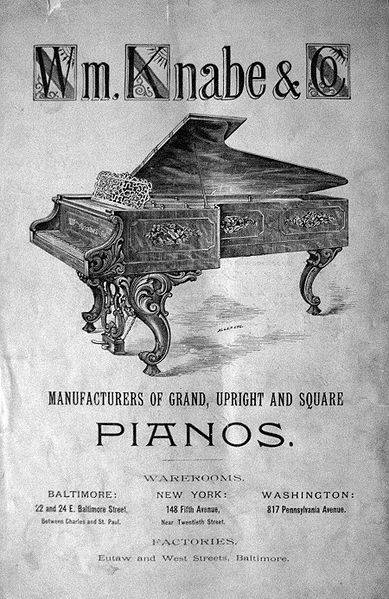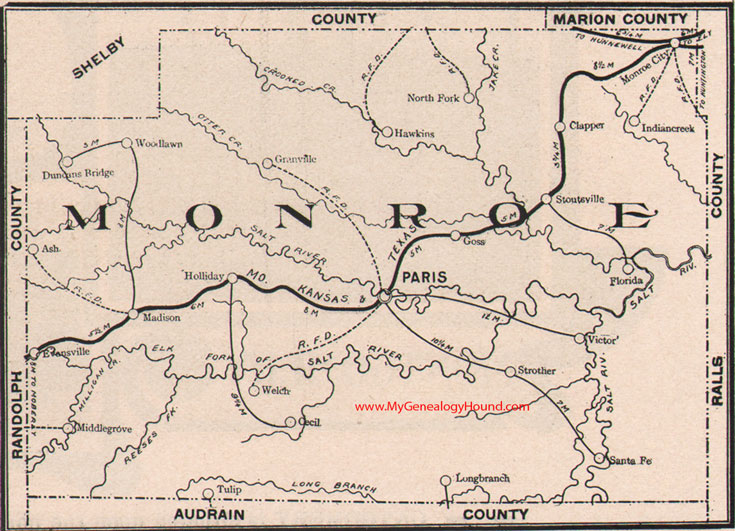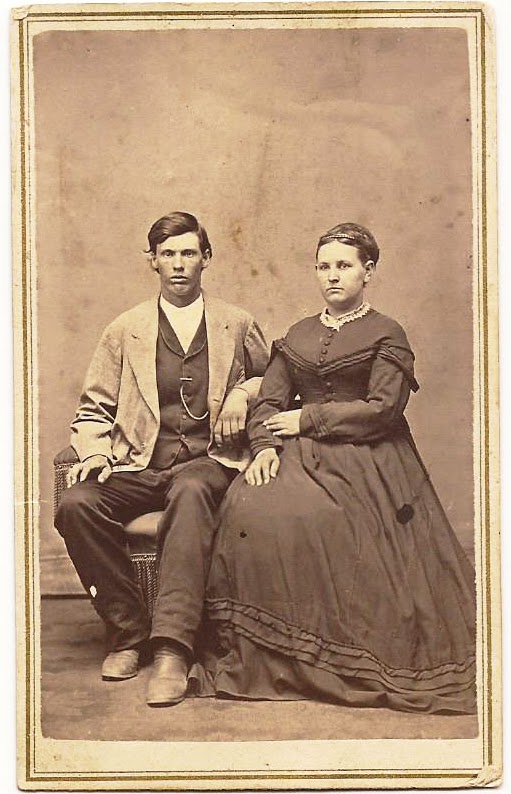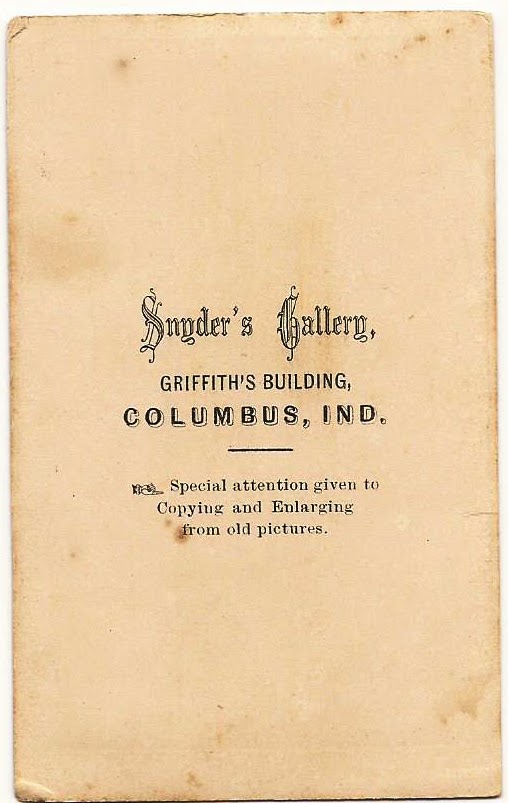Let others stay here and freeze if they wish; I’m
going to California.
- Helen Elliott,
an original member of the Indiana Colony in 1873[1]
In the spring of 1873, Perry first heard glowing accounts of life in California from a letter that was being passed around a group of his Indianapolis friends.[3] Many of the Hoosiers, including Perry himself, resolved that they would head to California as soon as possible. He joined the company in the hope of improving the health of his ailing wife, Hettie.[4] The small band of investors, calling themselves the “Indiana Colony,” immediately laid out their plans for departure.
However, their endeavors got off to a rocky start when the economy collapsed during the Panic of 1873. Perry Green described the devastating effect the financial depression had on the Indiana Colony:
Alas for the uncertainty of human calculations! The financial crash of 1873 fell upon the country like a clap of thunder from a clear sky, and failure, disaster, and bankruptcy swept like a tidal wave over the land, and the bright hopes of the “California Colony of Indiana” went down into the frightful vortex.[5]Although they had lost much of their financial backing, Perry Green and those faithful to the cause rallied to form the San Gabriel Orange Grove Association.[6] In essence, their perseverance transformed a dream into reality.
In 1875, the association finally purchased land; Perry Green’s investment secured him 60 acres in the San Gabriel Valley. [7] Before building one of the first homes in the colony, Perry assisted in laying underground irrigation pipes, surveying the land, and planting grape cuttings.[8] Then, Perry met with other community leaders to discuss a name for the new town. Someone suggested “Pasadena,” a Chippewa word that meant “of the valley.”[9] This name seemed to reflect the character of the beautiful landscape better than all the other proposals.
Many of Pasadena’s original citizens were educated professionals – doctors, lawyers, and journalists – with little to no agricultural experience. One visitor to Pasadena even remarked: “What a highly educated lot of farmers you have out here! Do they all talk so learnedly?”[10] In 1877, the celebrated naturalist, John Muir, wrote a letter which further illustrates this point:
There is nothing more remarkable in the character of the colony than the literary and scientific taste displayed. The conversations of most I have met here is seasoned with a smack of mental ozone, attic salt, which struck me as being rare among the tillers of California soil. People of taste and money in search of a home would do well to prospect the resources of this aristocratic little colony.[11]Yet Pasadena clearly needed more than scholarly attainment. Those who had even a rudimentary knowledge of agriculture were a huge asset to the community. Perry Green was an educated attorney, but as a boy, he had been employed as a farm hand in rural Indiana.[12] His early familiarity with farming now equipped him to guide his struggling neighbors. Eager to help his fellow farmers succeed, Perry and several others formed a society for the purpose of developing the necessary skills to cultivate fruits such as oranges, figs, and apricots.[13]
The novice farmers soon came to realize that adequate irrigation was the key to their success. As one California pioneer put it: “Water here means gold.”[14] This need resulted in the formation of the Land and Water Company of Pasadena in 1877. Perry Green was on the company’s first board of directors and was selected to fill the position of vice president, a role he continued for 25 years.[15]
Another issue in the early years of Pasadena was the anti-liquor ordinance. In the beginning, the majority of the colony, including Perry Green, was strongly in support of the Temperance Movement, forbidding even the cultivation of certain grapes that could be used in the production of wine.[16] Notably, during the first nine years of the settlement, there was not one single criminal prosecution.[17] However, with the arrival of new settlers who did not share the same sentiments, it became harder to keep the founding principles enforced. In 1888, Perry Green served as chairman of a mass meeting of 1,000 concerned Pasadena citizens. The deliberation resulted in a set of anti-liquor resolutions and an “enforcement committee,” of which Perry was a member.[18]
 Perry Green was the driving force in organizing many major financial and business institutions, particularly Pasadena’s first bank. Although he had no previous experience with banking, Perry saw the need for a bank and was willing to contribute his time and money to make the venture succeed. The bank prospered, and by 1886 it received a charter to become the First National Bank of Pasadena.[19] In addition to being the president of the First National Bank, Perry was involved in at least a dozen other civic establishments as a board member, trustee, or treasurer.
Perry Green was the driving force in organizing many major financial and business institutions, particularly Pasadena’s first bank. Although he had no previous experience with banking, Perry saw the need for a bank and was willing to contribute his time and money to make the venture succeed. The bank prospered, and by 1886 it received a charter to become the First National Bank of Pasadena.[19] In addition to being the president of the First National Bank, Perry was involved in at least a dozen other civic establishments as a board member, trustee, or treasurer.In the space of ten years, Pasadena had already outgrown its status as a quaint agrarian community and was well on its way to becoming a bustling city. As a result, it became necessary to create a better form of internal transportation. Perry Green embraced these changes and invested more of his time and money in streetcars and railroads, becoming reasonably wealthy in the process. He became both director and treasurer for the first streetcar company of Pasadena, as well as joining the Los Angeles and Pasadena Railway Company’s board of directors.[20]
With Pasadena’s central transportation system flourishing, Perry turned his attention to a new enterprise that would benefit his city. He had an idea to construct a railway into the Sierra Madre Mountains (now known as the San Gabriel Mountains), allowing adventurous tourists to experience the beauty of the landscape.[21] More importantly for Pasadena, the proposed railway would become a source of revenue. Perry provided some initial funds for the project and commissioned Thaddeus Lowe, a well-known engineer, to oversee the monumental task of building a track up the side of the steep mountain.[22]
On Independence Day 1893, a multitude of spectators attended the unveiling of the Mount Lowe Incline Railway, paying the substantial fee of $5 for a ride to the top of the mountain.[23] The completed railway was an incredible feat of engineering. Perry Green, as vice president of the Pasadena and Mount Wilson Railway Company, gave the opening remarks for the occasion: “The railroad is . . . such a triumph of engineering and construction and skill, as to challenge our unbounded admiration.”[24] Eventually, hotels were built at the top of the mountain, making Pasadena one of the most popular vacation spots of that era. Although the Mount Lowe Incline Railway no longer exists, it ultimately changed the character of Pasadena from an ordinary town into a well-known resort destination.
As an educated man, Perry Green naturally involved himself with the academic sector of Pasadena. The California Institute of Technology (also known as Caltech), was founded in 1891 as Throop Polytechnic Institute, a vocational and preparatory college. Perry Green, part of the initial board of directors, was elected as the institute’s first treasurer.[25] Furthermore, he took a philanthropic interest in the school, as shown in the following remarks made by his Throop colleagues:
Mr. Green has given the best that was in him for the advancement of this school. He yearned to help the young, frequently paying the tuition of deserving students who were unable to meet that expense, and following their career through the school with watchful interest.[26]Over time, the California Institute of Technology has emerged as one of the most prominent scientific and engineering schools in the country.
Without a doubt, the Rose Parade is [27] The first parades consisted of horse-drawn buggies ornately decorated with locally-grown roses and orange blossoms. But by the early twentieth century, some merchants who had previously sponsored the parade no longer saw its potential; they decided to withdraw funding that was crucial to the parade’s operation.[28] As treasurer of the Rose Parade committee, Perry appealed to the community for help. A group of supportive citizens responded by donating the needed $13,000.[29] Perry’s timely intervention was pivotal in preserving the city’s unique celebration. Pasadena’s most iconic tradition. Even so, it is not widely known that the New Year’s celebration was created to boost morale after a financial depression. By showcasing the best of what sunny Pasadena had to offer, Perry Green and other community leaders also hoped to renew interest in investors from the Midwest.
Perry M. Green’s steadfast guidance was truly essential to the formation, progress, and character of Pasadena. He overcame many obstacles to fulfill the vision that he had for his adopted homeland. Through hard work and careful investing, Perry amassed a great amount of wealth, which he generously poured back into his community. Even toward the end of his life, as his health declined, Perry continued to serve his city in countless ways. On the day of his funeral, all of Pasadena’s businesses closed their doors as a tribute to the city’s beloved founder.[30] The beautiful city of Pasadena, California stands as a legacy of Perry Green’s leadership, dedication, and ingenuity.
[1] James H. Madison, “Taking the
Country Barefooted: The Indiana Colony in Southern California,” California History, Fall 1990, 237.
[2] Michael Snyder, “Flower Power,” Indianapolis Monthly, Dec 1998, accessed
January 15, 2015, 86. https://books.google.com/books?id=Fh0DAAAAMBAJ&printsec=frontcover#v=onepage&q&f=false
[3] R. W. C. Farnsworth, A Southern California Paradise
(Pasadena: Farnsworth, 1883), 35.
https://books.google.com/books?id=6XcUAAAAYAAJ&printsec=frontcover#v=onepage&q&f=false
[4] James Miller Guinn, Historical and Biographical Record of
Southern California, (Chicago, Chapman Publishing Company, 1902), 227. https://books.google.com/booksid=3BU1AQAAMAAJ&printsec=frontcover#v=onepage&q&f=false
[5] Farnsworth, 35.
[6]
Guinn, 226.
[7] “Appreciating Pasadena, Garden of
the Californian Dream,” Kim Weir, accessed January 19, 2015,
http://www.uptheroad.org/appreciating-pasadena-garden-of-the-california-dream
[8] Ann Scheid Lund, Historic Pasadena: An Illustrated History (Pasadena,
HPN Books, 1999), accessed January 15, 2015, 20-21. https://books.google.com/books?id=3HLb4SY0uyEC&printsec=frontcover&source=gbs_atb#v=onepage&q&f=false
[11] Ibid, 25.
[12]
Guinn, 227.
[13]
Lund, 25.
[14] Madison, 240.
[15] Guinn, 227.
[16] Farnsworth, 39.
[17] Ibid, 46.
[18] Hiram Alvin Reid, A History of Pasadena, (Pasadena,
Pasadena History Company, 1895), 256.
https://books.google.com/books?id=uRU1AQAAMAAJ&printsec=frontcover#v=onepage&q&f=false
[19] J. W. Wood, Pasadena, California, Historical and Personal: A Complete History of
the Organization of the Indiana Colony, (Wood, 1917), 246.
https://books.google.com/booksid=YxQpAAAAYAAJ&printsec=frontcover#v=onepage&q&f=false
[20] Reid, 430, 434.
[21] Michael A. Patris, Mount Lowe Railway, (Arcadia Publishing,
2007), 8.
https://books.google.com/books?id=IFEmrlwqgUIC&printsec=frontcover#v=onepage&q&f=false
[22] Ibid, 9.
[23] Ibid, 45.
[24] Reid, 448.
[25] Ibid, 191.
[26] “Honor His Memory – Citizens Pay
Tribute To Late P. M. Green,”Los Angeles Herald, March 25, 1903, accessed
January 19, 2015. http://cdnc.ucr.edu/cgi-bin/cdnca=d&d=LAH19030325.1.10&e=-------en--20--1--txt-txIN------#
[27] Snyder, 92.
[28] Lee E. Johnson and C. W. Taylor, Eminent Californians 1953, (Palo Alto,
C. W. Taylor Publishing, 1953), 15.
[29] Ibid, 15.
[30] “Last Honors Paid – Funeral of
Late P. M. Green,” Los Angeles Herald, March 27, 1903, accessed January 19,
2015. http://cdnc.ucr.edu/cgi-bin/cdnc?a=d&d=LAH19030327.2.140
.PNG)
%2Band%2BP%2BM%2BGreen%2B(right)%2Bhouses.PNG)













.PNG)










